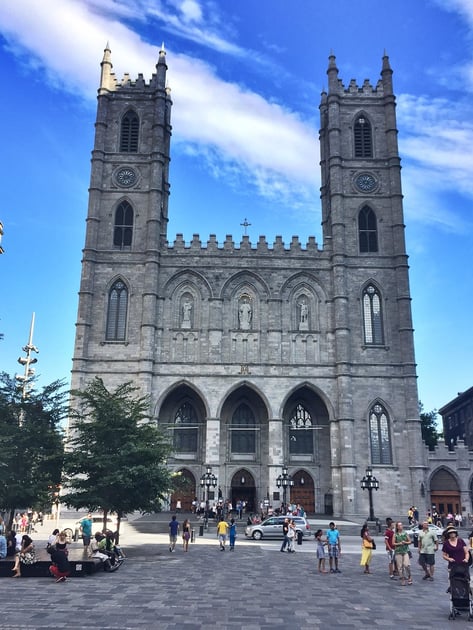
While cities begin considering lifting the stay-at-home orders, we’re all left wondering when we can get back to enjoying outdoor gatherings again. The possibility of taking short car trips to reconnect with local sights and historic architectural gems that may have been overlooked take on a new appeal, while respecting responsible social distancing measures. After we no longer need to stay six feet apart, we may value our community’s open spaces more, like Place d'Armes. Not only for active use, but as an opportunity to be (somewhat) more together.
Place d'Armes is a key piece of Montreal, historically and aesthetically speaking. Perched atop a cliff, it is the second oldest public site in the city, having been created in 1693 by the Sulpicians - a society of secular priests founded in Paris in 1642 who engaged men to teach in seminaries. Throughout its early history it was a training ground for the military and the site of significant cultural gatherings and parades.
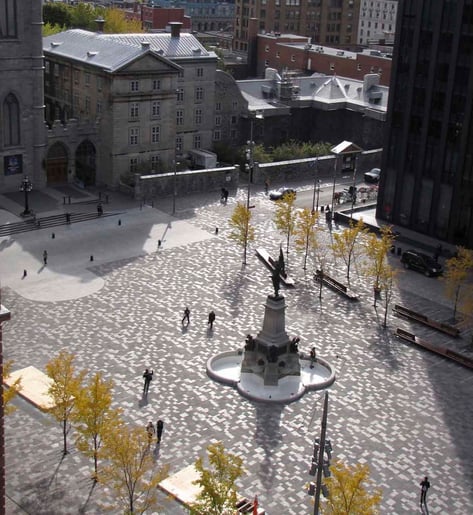
Place d'Armes is a key piece of Montreal, the second oldest public site in the city.
The square is as aesthetically important as it is historically charged: at its center is a majestic Gothic fountain, a beautiful monument to Paul de Chomedey, the French military officer who founded Montreal. And it’s surrounded by what seems like a “best of” Montreal monuments: Notre-Dame Basilica, the Saint-Sulpice Seminary, and the majestic Aldred building, an Art Deco icon built in 1931 for the New York-based Aldred & Company. The 23-story, tiered building has been called Canada's answer to the Empire State Building and was designed by Ernest Isbell Barott, of the firm Barott and Blackader. Completed the same year that the finishing touches were being added to the Empire State Building, the Aldred has an exterior clad in the same Indiana Limestone, used as an homage to the Manhattan landmark. Standing tall for nearly a hundred years, the Aldred building is a testament to the durability of Indiana Limestone installed in harsh freeze-thaw conditions experienced in colder climates.
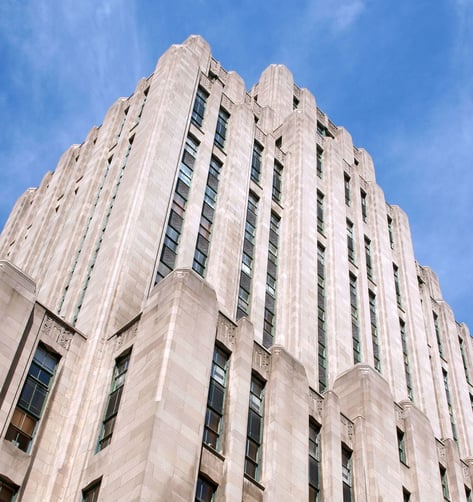 INDIANA LIMESTONE - FULL COLOR BLEND™ cladding adorns the Aldred Building overlooking Place D'Armes.
INDIANA LIMESTONE - FULL COLOR BLEND™ cladding adorns the Aldred Building overlooking Place D'Armes.
Through the centuries the Place D’Armes has been an important gathering space; in turns it has been a public garden, a ceremonial space, a venue for state funerals, and more. Despite a succession of changes and updates to the square over the years and decades—each of which has unearthed stunning archaeological artifacts—the citizens of the city have been almost reflexively opposed to any new project on the square over the years.
And so it was, at first, with the latest proposal to renovate the square. The project was met with trepidation by the denizens of Montreal who were nervous that the iconic square—so imbued with historical meaning to generations—would be radically changed. These reservations only confirmed the square’s importance to the city and its people.

The more modern Art Deco styling of the Indiana Limestone clad Aldred building complements the stone work of the historic Notre-Dame Basilica.
Local firm Cardinal Hardy was chosen to develop the renovation. Their project, a mosaic of North American quarried granite pavers carpeting the square, expanded the pedestrian space without expanding the footprint of the square, making it an enhanced gathering place. Their guiding principle was the idea of a “story set in stone,” honoring the square’s history while making room for the future. The idea of integrating the future with the past is expressed with the use of the newly-quarried granite pavers existing alongside the old stones buffed by years of use.
CAMBRIAN BLACK® granite and SAINT SEBASTIEN™ granite pavers were used alongside repurposed granite pavers that once surrounded planting beds at the site, and other pavers with bronze inlaid fleurs-de-lis that were added to the site in 1960. Through the use of these contrasting textures and stones, the mosaic paving pattern also brings out the rustic characteristics of the square’s major historical periods. The new paving carpet also integrates beautifully with its neighboring buildings, creating a consistent, level grade that eliminated elevation changes that resulted from ad-hoc additions performed over time.
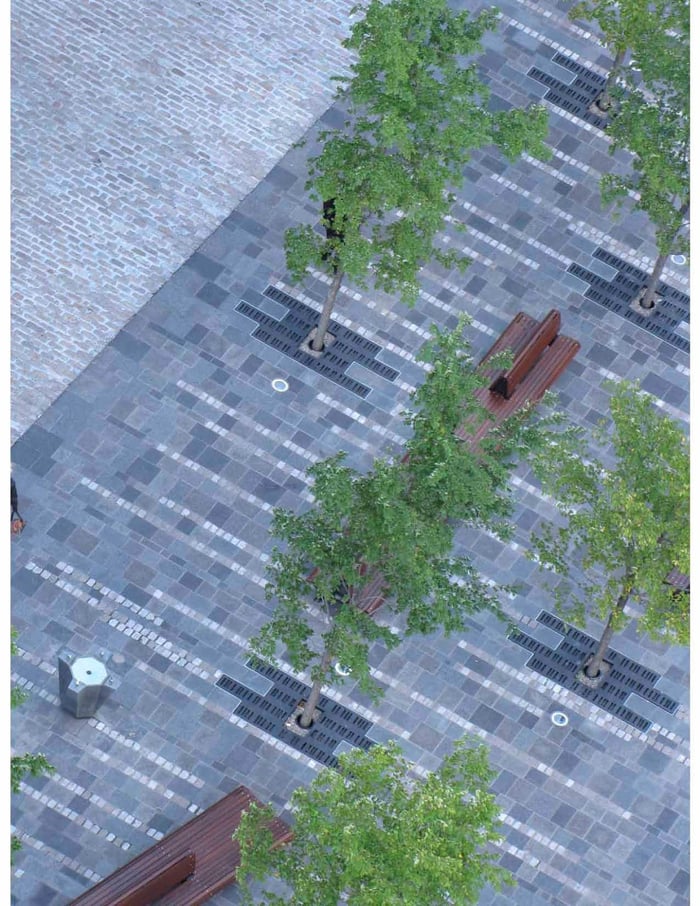
A mosaic of Cambrian Black granite and Saint Sebastien granite pavers alongside repurposed granite pavers carpets the Place D’Armes square.
Cambrian Black granite and Saint Sebastien granite were chosen for this project for multiple reasons: they’re both timeless granites and Canadian classics—available exclusively from Polycor’s local quarries— and both played a contextual role in the historical design intent of the plaza. Saint Sebastien granite, a heritage natural stone quarried a short distance from Montreal, has small grains of warm gray and subtle beige colors that blend well with many other stones and provides lighter accents in the blend of darker stones.
In addition to the durability these granites possess for high-traffic areas, as compared to concrete pavers which would develop exposed aggregate over time, the stones were also selected for their sustainability credentials. Cambrian Black granite, for example, is one of the few black granites in the world that don’t require any resins or dyes to maintain its deep black tone, even with textured finishes. Located about 150 miles north of Montreal, the quarry in Saint-Nazaire, Quebec, is a sustainable (NSC-373) certified quarry by the Natural Stone Council. Maintaining compliance with the standards of the NSC helps further reduce the carbon footprint of the site, where measures such as water recycling and recuperation in daily operations helps reduce the embodied carbon of the stone itself.
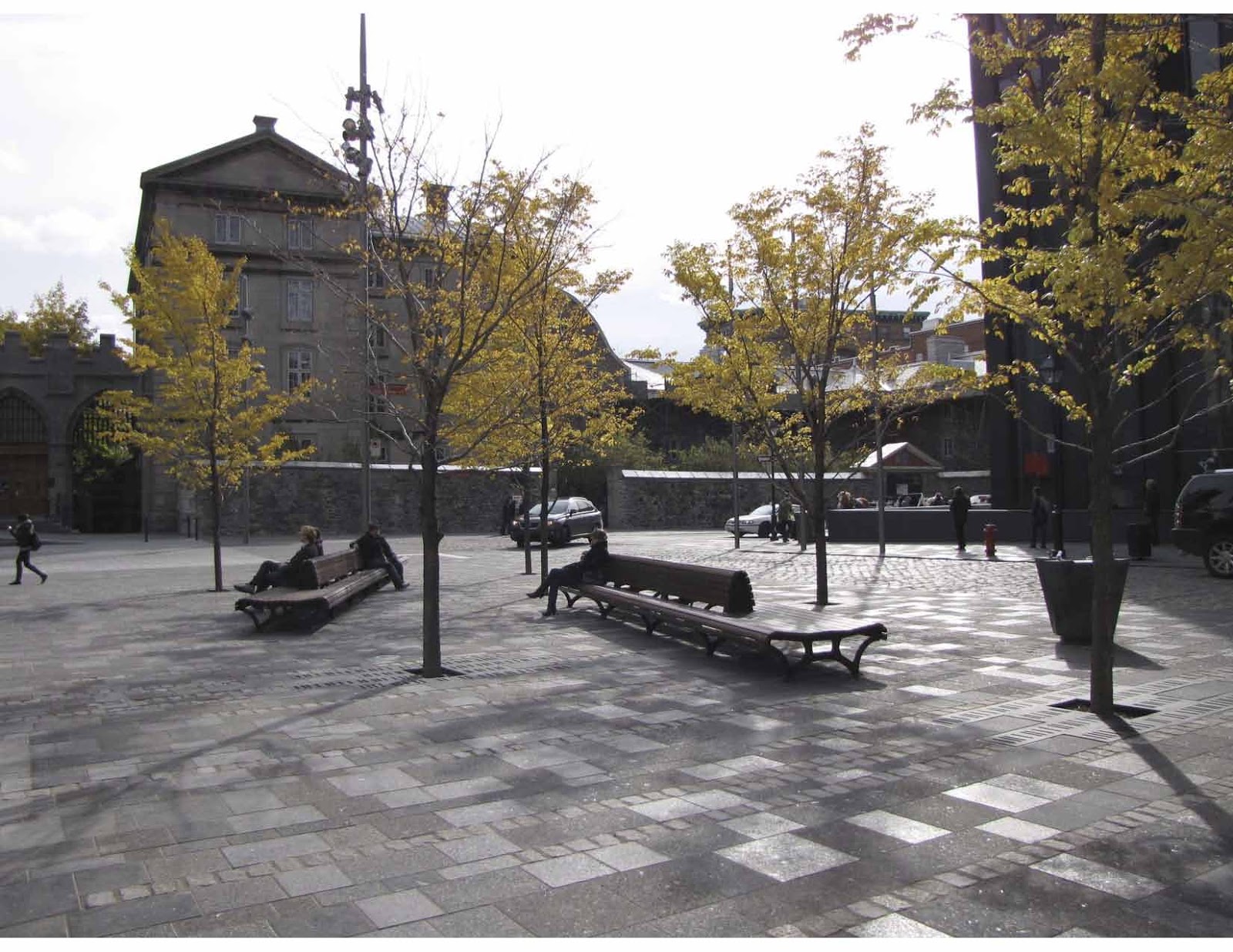
Cambrian Black granite and Saint Sebastien granite are timeless, Canadian classics that are known for their sustainability and durability, making them ideal for applications like a high-traffic outdoor space.
The redevelopment of Place D’Armes was met with hesitation, but after its completion has been embraced by the citizens of Montreal because it was done with respect. Even the original chestnut trees around the square were treated with thoughtful care; rather than rip them out, 18 old-growth Ohio chestnut trees were preserved and methodically lifted, moved and transplanted to nearby Maisonneuve Park.
The spatial arrangement, excellent sight-lines, street furniture, and the quality of the stones used, help to make a beautiful and welcoming space that is a dialogue between old, new and now. By treating the square’s historical heritage with the same reverence that the people of the city do, the redevelopment has made the people of Montreal once again happy with their exceptionally symbolic square that they’re looking forward to enjoying again as things begin to return to (a new) normal.
Have questions about your upcoming project? Consult with one of our experts who can guide you in your material specifications and sourcing.
